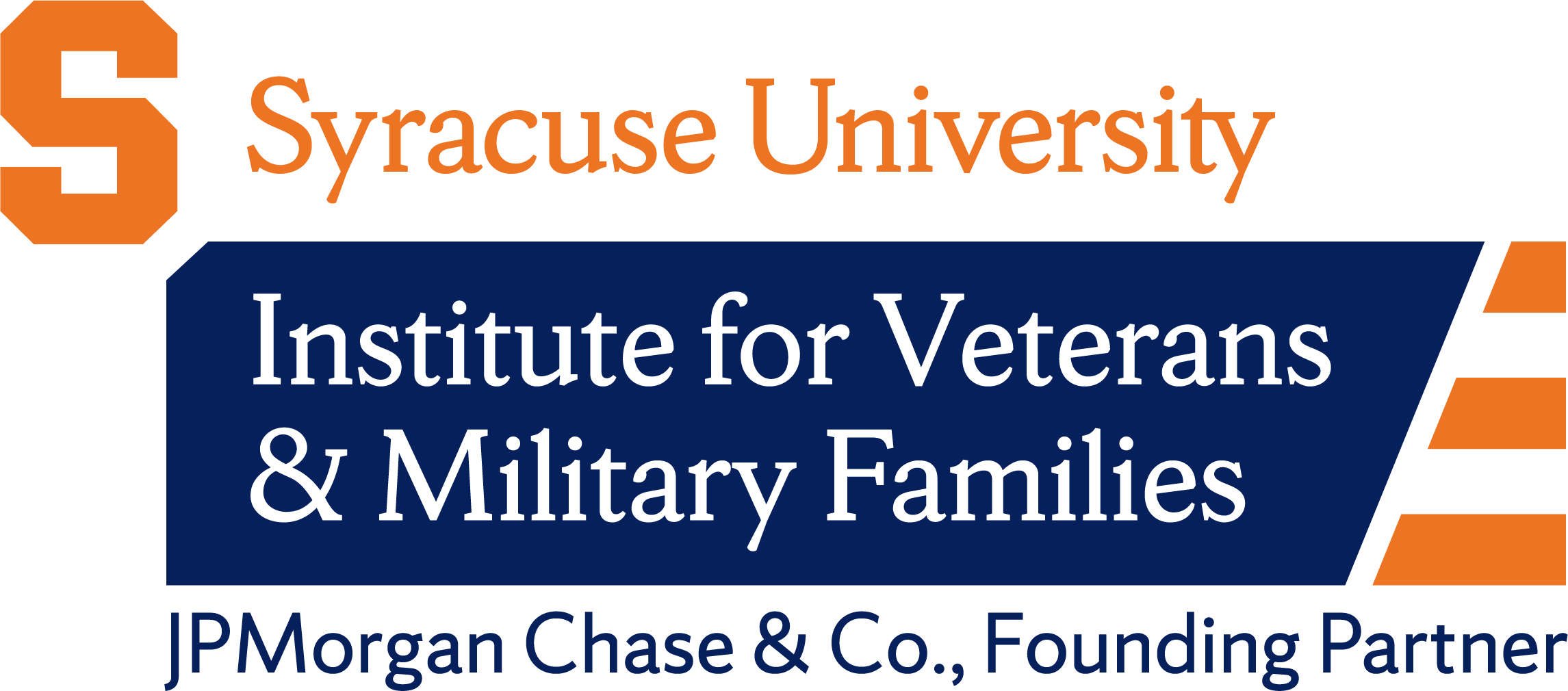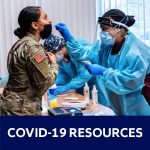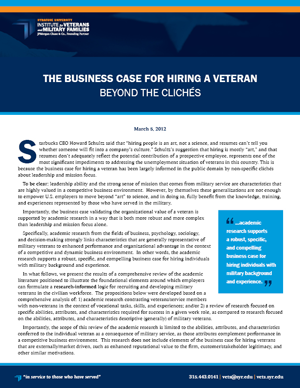Employer Resources
Are you a business looking to hire someone who is military-connected? Explore the reports and resources below on how to best leverage military talent in your organization
Major Initiatives and Coalitions
USAA / SHRM Foundation Ambassador Program
Veteran Jobs Mission
Hiring Our Heroes
Blackstone Veterans Initiative
Pittsburgh Veterans Employment Coalition
USAA / SHRM Foundation Ambassador Program

The SHRM Foundation, alongside the generous support and visionary partnership of USAA and the USAA Foundation, is committed to transforming the approach of HR professionals in attracting, hiring and retaining members of the military community. Together, we strive to provide high-quality education and resources designed to ensure the success of transitioning service members, veterans and their families in the workplace.
Veteran Jobs Mission
 Our mission is to address the most pressing needs of veterans in finding and keeping jobs. Through this uncertain time, we’ll continue our work to ensure that America’s companies keep current and former servicemembers a key part of their long-term talent strategy.
Our mission is to address the most pressing needs of veterans in finding and keeping jobs. Through this uncertain time, we’ll continue our work to ensure that America’s companies keep current and former servicemembers a key part of their long-term talent strategy.
Hiring Our Heroes
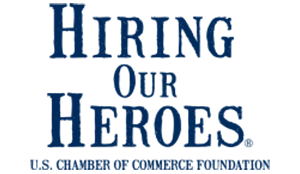 The U.S. Chamber of Commerce Foundation’s Hiring Our Heroes (HOH) initiative launched in March 2011 as a nationwide effort to connect veterans, service members, and military spouses with meaningful employment opportunities. Working with the U.S. Chamber of Commerce’s vast network of state and local chambers and strategic partners from the public, private, and non-profit sectors, our goal is to create a movement across America in hundreds of communities where veterans and military families return every day.
The U.S. Chamber of Commerce Foundation’s Hiring Our Heroes (HOH) initiative launched in March 2011 as a nationwide effort to connect veterans, service members, and military spouses with meaningful employment opportunities. Working with the U.S. Chamber of Commerce’s vast network of state and local chambers and strategic partners from the public, private, and non-profit sectors, our goal is to create a movement across America in hundreds of communities where veterans and military families return every day.
Blackstone Veterans Initiative
 At Blackstone, we firmly believe in providing for those that served the United States. We are an industry leader in supporting the employment and professional development of veterans and military families within our firm, across our portfolio and through our nonprofit partnerships. Veterans bring unique value to our businesses and we’re committed to supporting their growth.
At Blackstone, we firmly believe in providing for those that served the United States. We are an industry leader in supporting the employment and professional development of veterans and military families within our firm, across our portfolio and through our nonprofit partnerships. Veterans bring unique value to our businesses and we’re committed to supporting their growth.
Pittsburgh Veterans Employment Coalition
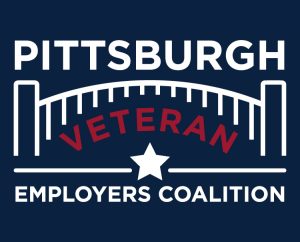 Local employers of all types, alongside support of The Heinz Endowments, have gathered regularly over the past 18 months to collaborate and share model practices to recruit and hire military-connected talent, maximize the value of veterans in the workplace, and leverage Pittsburgh’s higher education institutions to develop a robust military talent pipeline into the community.
Local employers of all types, alongside support of The Heinz Endowments, have gathered regularly over the past 18 months to collaborate and share model practices to recruit and hire military-connected talent, maximize the value of veterans in the workplace, and leverage Pittsburgh’s higher education institutions to develop a robust military talent pipeline into the community.
Today, this group has formed into the Pittsburgh Veteran Employer Coalition (PVEC) comprised and led by companies committed to working together to attract military talent to Greater Pittsburgh, support the development of military hiring and development initiatives, and share best practices to recruit and retain veterans in their companies.
Toolkits and Leading Practices
The Veteran Employer Roadmap
SHRM Employing Veterans Digital Toolkit
IVMF HR Manger Guide on Military Spouse Hiring
VJM Guides—Start-up, Mentoring, & Resource Groups
Get Skills to Work Toolkit
Guide to Leading Policies, Practices & Resources
The Veteran Employer Roadmap
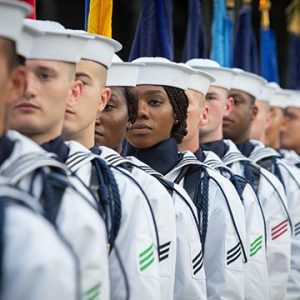 Find your path to hiring and retaining veterans and military spouses. Read articles from experts in the veteran recruiting, hiring, and retaining to learn how you can use their patterns of success in your business.
Find your path to hiring and retaining veterans and military spouses. Read articles from experts in the veteran recruiting, hiring, and retaining to learn how you can use their patterns of success in your business.
SHRM Employing Veterans Digital Toolkit
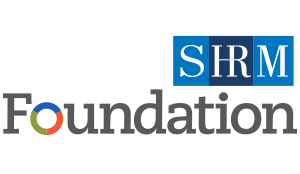 Veterans are valuable members of our workforce who have in-demand skills that are strengthened and enhanced by military service . Yet, veterans face difficulties with 90% of veterans indicating there were obstacles in attaining employment. Proactive and well-informed employment practices targeted at attracting, hiring and retaining veterans—to be led and managed by HR professionals—can mitigate challenges faced by employers and veterans. This toolkit—provided with support from JPMorgan Chase & Co.—provides no-cost, high-quality resources to HR professionals as they lead and manage efforts to engage and integrate veterans into their workforce.
Veterans are valuable members of our workforce who have in-demand skills that are strengthened and enhanced by military service . Yet, veterans face difficulties with 90% of veterans indicating there were obstacles in attaining employment. Proactive and well-informed employment practices targeted at attracting, hiring and retaining veterans—to be led and managed by HR professionals—can mitigate challenges faced by employers and veterans. This toolkit—provided with support from JPMorgan Chase & Co.—provides no-cost, high-quality resources to HR professionals as they lead and manage efforts to engage and integrate veterans into their workforce.
IVMF HR Manger Guide on Military Spouse Hiring
 This product, a training slide deck designed for hiring managers and human resource professionals is the third in a series of products that illustrates the unique strengths and challenges that military spouses bring to the workforce while supporting their service member’s military career. This training tool, designed to be used with the other two products in the series, offers a “hand-on” way for those interested in hiring military spouses to gain key insights and ways to train, leverage talent, and communicate when employing military spouses.
This product, a training slide deck designed for hiring managers and human resource professionals is the third in a series of products that illustrates the unique strengths and challenges that military spouses bring to the workforce while supporting their service member’s military career. This training tool, designed to be used with the other two products in the series, offers a “hand-on” way for those interested in hiring military spouses to gain key insights and ways to train, leverage talent, and communicate when employing military spouses.
VJM Guides—Start-up, Mentoring, & Resource Groups
 The Veteran Jobs Mission partnered with Institute for Veterans and Military Families at Syracuse University (IVMF), to develop leading practices based off the experiences of Veteran Jobs Mission companies. Employers can use these leading practices as helpful tools when building or enhacing their veteran hiring programs.
The Veteran Jobs Mission partnered with Institute for Veterans and Military Families at Syracuse University (IVMF), to develop leading practices based off the experiences of Veteran Jobs Mission companies. Employers can use these leading practices as helpful tools when building or enhacing their veteran hiring programs.
Get Skills to Work Toolkit

The Institute for Veterans and Military Families at Syracuse University (IVMF) and General Electric (GE) are partnering to empower our nation’s employers with the tools, strategies, and peer resources to adopt a collaborative and strategic approach to veteran employment. Select tools include best-in-class practices, processes, resources and programs positioned to increase employment opportunities for our nation’s veterans, contributed by those using them and curated by IVMF experts.
Guide to Leading Policies, Practices & Resources
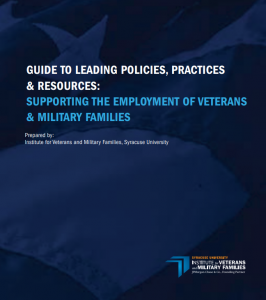
Since 2001, more than 2.8 million military personnel have made the transition from military to civilian life. Another one million service members will make this transition over the next five years. For a great majority of the men and women that have or will make this
transition, their most pressing concern is employment.
Featured Data and Insights
Monthly Veteran Employment Data
The Business Case for Hiring A Veteran
DAV – The Veteran Advantage
CNAS – Veteran Pathways to Employment
CNAS – Veteran Retention and Performance
Call of Duty Endowments – Underemployment
Veteran Job Retention Survey
Monthly Veteran Employment Data
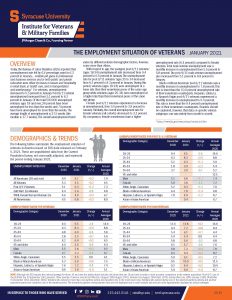
Each month the Bureau of Labor Statistics (BLS) releases their employment and unemployment report. View the key insights from those reports focused on veteran employment.
The Business Case for Hiring A Veteran
The IVMF has issued a brief, “The Business Case for Hiring a Veteran: Beyond the Clichés,” which draws from academic literature to suggest a robust, specific and compelling business case for hiring individuals with military background and experience. The report details the results of a comprehensive review of academic literature from the fields of business, psychology, sociology, and organizational behavior positioned to illustrate the foundational elements around which employers can formulate a research-informed logic for recruiting and developing military veterans in the civilian workforce. The business case is based on 10 research-informed propositions on the value of a veteran in a competitive business environment.
DAV – The Veteran Advantage
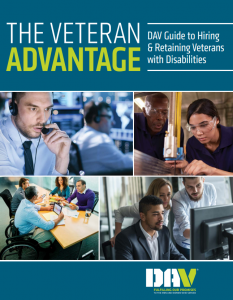 America’s veterans answered the call of duty, and many sacrificed in return. Now, more and more employers—both large and small—are stepping up to repay their sacrifice, at least in some small measure, by hiring veterans with disabilities. As a result, these employers
America’s veterans answered the call of duty, and many sacrificed in return. Now, more and more employers—both large and small—are stepping up to repay their sacrifice, at least in some small measure, by hiring veterans with disabilities. As a result, these employers
are realizing several benefits. When you hire a veteran, your organization gets a loyal, team-oriented employee with job-ready
skills, tested leadership abilities and a strong, mission-focused work ethic. Nearly 4 million veterans have a service-connected disability and are among the most resilient members of society, having served in the military and overcome adversity.
This guide is intended to help employers navigate the often-unclear terrain of recruiting, hiring and retaining veterans with disabilities. Much of the information and many of the strategies, lessons learned and best practices contained here also apply to hiring all veterans. What makes this a must-have resource for employers is that it explains the benefits of hiring veterans and focuses on solutions, including approaches unique to hiring and retaining veterans with disabilities, while weaving in the real-life experiences of different-sized employers and voices of veterans.
CNAS – Veteran Pathways to Employment
 The issue of employment for post-9/11 veterans came to a head nearly a decade ago, when the national economy was ailing and a spike in veteran unemployment coincided with the height of the wars in Iraq and Afghanistan. Following the first nine years of war in Afghanistan and Iraq, the well-being of the veteran community was a major public concern. This concern was heightened in the aftermath of the economic crash of 2008. The overall economy was reeling, but available data showed that unemployment was particularly high among America’s post-9/11 veterans. This confluence of factors led to concerted efforts to understand and to rectify the challenges facing veterans seeking work.
The issue of employment for post-9/11 veterans came to a head nearly a decade ago, when the national economy was ailing and a spike in veteran unemployment coincided with the height of the wars in Iraq and Afghanistan. Following the first nine years of war in Afghanistan and Iraq, the well-being of the veteran community was a major public concern. This concern was heightened in the aftermath of the economic crash of 2008. The overall economy was reeling, but available data showed that unemployment was particularly high among America’s post-9/11 veterans. This confluence of factors led to concerted efforts to understand and to rectify the challenges facing veterans seeking work.
CNAS – Veteran Retention and Performance
 With more than 11 million veterans in the workforce and approximately 175,000 service members discharged each year from active service, the overall economic performance of veterans is a critical component of veteran reintegration, wellness, and success.1 Indeed, the successful transition of veterans after service is imperative not just for their own economic well-being but for the viability of the All-Volunteer Force, to the extent that this success influences the propensity of future generations to serve in the military.
With more than 11 million veterans in the workforce and approximately 175,000 service members discharged each year from active service, the overall economic performance of veterans is a critical component of veteran reintegration, wellness, and success.1 Indeed, the successful transition of veterans after service is imperative not just for their own economic well-being but for the viability of the All-Volunteer Force, to the extent that this success influences the propensity of future generations to serve in the military.
Call of Duty Endowments – Underemployment
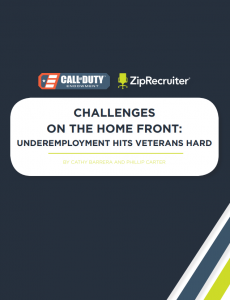 Veteran employment is critical both to the national economy—with veterans constituting 8.3% of the adult population, and 6.4% of the civilian labor force1 — and to our country as well. The ability to sustain an all-volunteer force, which is a critical component of our national security, hinges on both the perception and fact of military service being a gateway to a strong career.
Veteran employment is critical both to the national economy—with veterans constituting 8.3% of the adult population, and 6.4% of the civilian labor force1 — and to our country as well. The ability to sustain an all-volunteer force, which is a critical component of our national security, hinges on both the perception and fact of military service being a gateway to a strong career.
Thus, the success of veterans after service, and the positive perception of veterans as assets to their employers and communities, is vital to the success of our military. For this and many other reasons, government and nongovernment organizations—both for and
not-for-profit—have invested in a variety of programs over the years to assist veterans in the civilian labor market.
Veteran Job Retention Survey
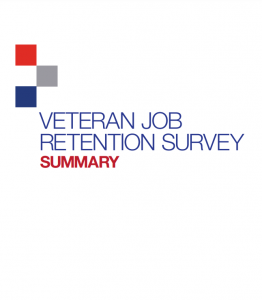 Three primary findings emerged from the survey. First, nearly half of those surveyed stayed in their first post-separation position 12 months or less. Further, there is an association between job tenure and job alignment with the respondent’s preferred career field. Second, the three employment-related issues of greatest importance to respondents were: opportunities to apply
Three primary findings emerged from the survey. First, nearly half of those surveyed stayed in their first post-separation position 12 months or less. Further, there is an association between job tenure and job alignment with the respondent’s preferred career field. Second, the three employment-related issues of greatest importance to respondents were: opportunities to apply
their skills and abilities; adequate benefits and pay; and meaningfulness of the work. Third, respondents’ biggest obstacle to obtaining initial employment was finding opportunities that match their military training and experience.
Stay up-to-date on the latest resources from IVMF.
[gravityform id=”8″ title=”false” description=”false”]
Thank you to our generous sponsor, USAA, for making this resource hub possible.
